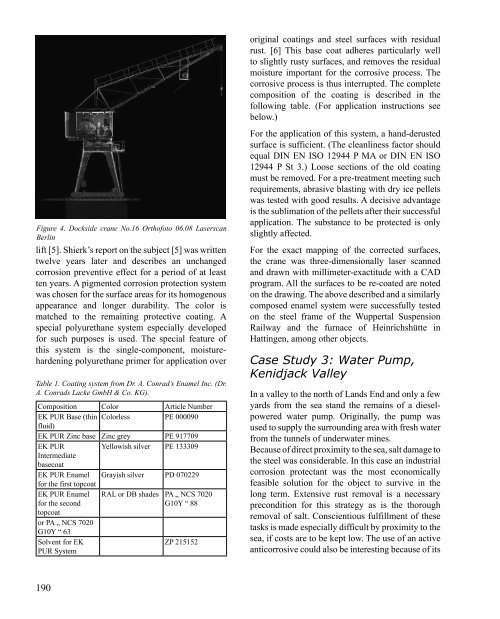dk nkf - Nordisk Konservatorforbund Danmark
dk nkf - Nordisk Konservatorforbund Danmark
dk nkf - Nordisk Konservatorforbund Danmark
Create successful ePaper yourself
Turn your PDF publications into a flip-book with our unique Google optimized e-Paper software.
Figure 4. Dockside crane No.16 Orthofoto 06.08 Laserscan<br />
Berlin<br />
lift [5]. Shierk’s report on the subject [5] was written<br />
twelve years later and describes an unchanged<br />
corrosion preventive effect for a period of at least<br />
ten years. A pigmented corrosion protection system<br />
was chosen for the surface areas for its homogenous<br />
appearance and longer durability. The color is<br />
matched to the remaining protective coating. A<br />
special polyurethane system especially developed<br />
for such purposes is used. The special feature of<br />
this system is the single-component, moisturehardening<br />
polyurethane primer for application over<br />
Table 1. Coating system from Dr. A. Conrad’s Enamel Inc. (Dr.<br />
A. Conrads Lacke GmbH & Co. KG).<br />
Composition Color Article Number<br />
EK PUR Base (thin Colorless<br />
fluid)<br />
PE 000090<br />
EK PUR Zinc base Zinc grey PE 917709<br />
EK PUR<br />
Intermediate<br />
basecoat<br />
Yellowish silver PE 133309<br />
EK PUR Enamel<br />
for the first topcoat<br />
Grayish silver PD 070229<br />
EK PUR Enamel RAL or DB shades PA „ NCS 7020<br />
for the second<br />
topcoat<br />
or PA „ NCS 7020<br />
G10Y “ 63<br />
G10Y “ 88<br />
Solvent for EK<br />
PUR System<br />
ZP 215152<br />
190<br />
original coatings and steel surfaces with residual<br />
rust. [6] This base coat adheres particularly well<br />
to slightly rusty surfaces, and removes the residual<br />
moisture important for the corrosive process. The<br />
corrosive process is thus interrupted. The complete<br />
composition of the coating is described in the<br />
following table. (For application instructions see<br />
below.)<br />
For the application of this system, a hand-derusted<br />
surface is sufficient. (The cleanliness factor should<br />
equal DIN EN ISO 12944 P MA or DIN EN ISO<br />
12944 P St 3.) Loose sections of the old coating<br />
must be removed. For a pre-treatment meeting such<br />
requirements, abrasive blasting with dry ice pellets<br />
was tested with good results. A decisive advantage<br />
is the sublimation of the pellets after their successful<br />
application. The substance to be protected is only<br />
slightly affected.<br />
For the exact mapping of the corrected surfaces,<br />
the crane was three-dimensionally laser scanned<br />
and drawn with millimeter-exactitude with a CAD<br />
program. All the surfaces to be re-coated are noted<br />
on the drawing. The above described and a similarly<br />
composed enamel system were successfully tested<br />
on the steel frame of the Wuppertal Suspension<br />
Railway and the furnace of Heinrichshütte in<br />
Hattingen, among other objects.<br />
Case Study 3: Water Pump,<br />
Kenidjack Valley<br />
In a valley to the north of Lands End and only a few<br />
yards from the sea stand the remains of a dieselpowered<br />
water pump. Originally, the pump was<br />
used to supply the surrounding area with fresh water<br />
from the tunnels of underwater mines.<br />
Because of direct proximity to the sea, salt damage to<br />
the steel was considerable. In this case an industrial<br />
corrosion protectant was the most economically<br />
feasible solution for the object to survive in the<br />
long term. Extensive rust removal is a necessary<br />
precondition for this strategy as is the thorough<br />
removal of salt. Conscientious fulfillment of these<br />
tasks is made especially difficult by proximity to the<br />
sea, if costs are to be kept low. The use of an active<br />
anticorrosive could also be interesting because of its

















